Ageing and sexing details:
|
JAN - JUL: after-second-year
male |
Males are easily
distinguished from females by having a large ruby-red crown, but beware that in a relaxed state the crown can be largely to entirely concealed by surrounding olive head feathers.
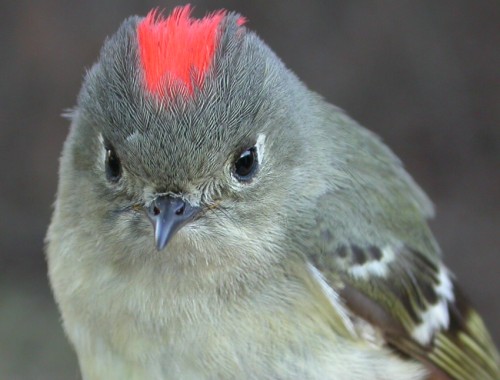
An ASY male with its ruby crown feathers nicely exposed.
Photo by Marcel Gahbauer,
McGill Bird Observatory (QC), April 2006
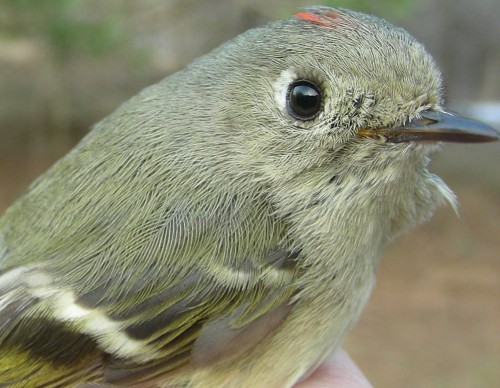
A more typical view, with only a hint of red visible in the crown when relaxed.
Photo by Marie-Anne Hudson,
McGill Bird Observatory (QC), May 2008
ASY kinglets lack molt limits on the wing and feathers tend to average somewhat broader and with more greenish edging than on SY birds, but note that the distinctions are subtle and often insufficient to determine age.
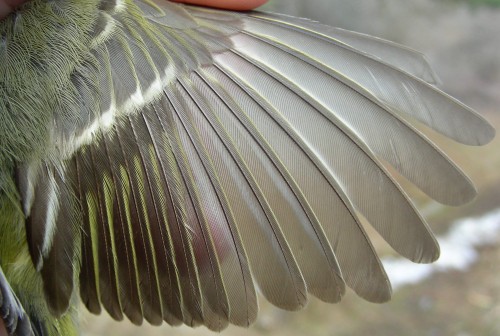
A typical ASY wing, showing fairly broad primary
coverts with green edging.
Photo by Marie-Anne Hudson,
McGill Bird Observatory (QC), April 2008
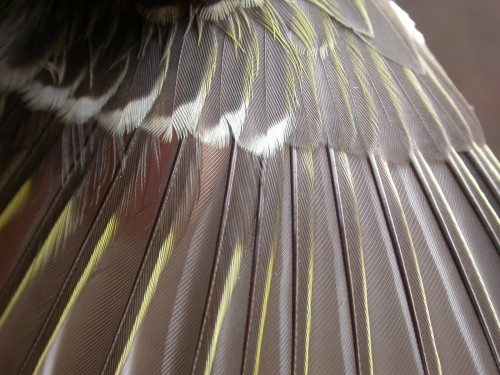
A close-up of the coverts, highlighting the green edging on the broad, rounded primary coverts.
Photo by Marcel Gahbauer,
McGill Bird Observatory (QC), April 2006
ASY kinglets tend to have rectrices that are more broad and rounded than those of SY birds, but there is a fair amount of variability and by spring the tail may be somewhat worn and difficult to assess reliably. If the wing
characteristics are also unclear, such an individual should be
considered AHY.
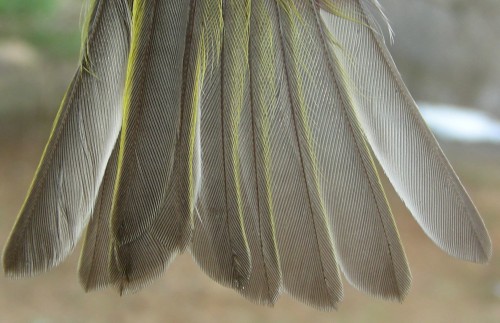
Although not an extreme case, the outer rectrices are sufficiently broad and rounded at
the tip to suggest that these are likely basic rather than juvenile feathers, and that this
is therefore likely an ASY bird on the basis of the tail.
Photo by Marie-Anne Hudson,
McGill Bird Observatory (QC), April 2008
RETURN TO AGE/SEX
OVERVIEW
|
JAN - JUL: after-second-year
female |
Females have olive crowns, but may sometimes have 1-2 red or
orange-red feathers in the centre of the crown.
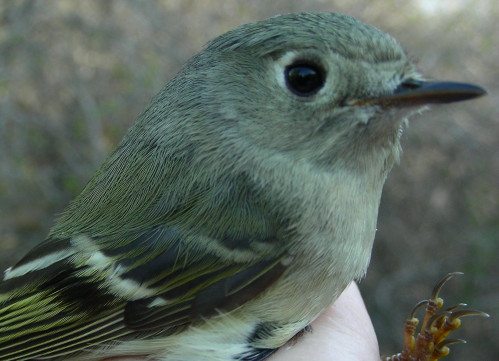
A typical ASY female, showing no red on the crown.
Photo by Marie-Anne Hudson,
McGill Bird Observatory (QC), April 2009
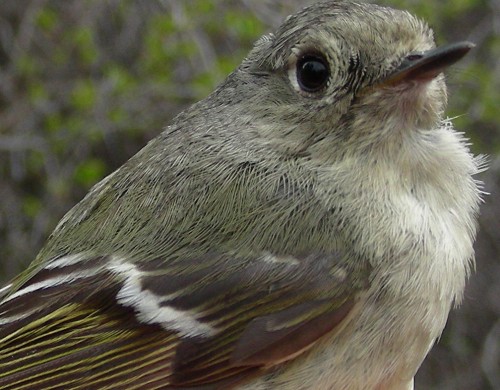
Another ASY female.
Photo by Marie-Anne Hudson,
McGill Bird Observatory (QC), May 2008
ASY kinglets lack molt limits on the wing and feathers tend to average somewhat broader and with more greenish edging than on SY birds, but note that the distinctions are subtle and often insufficient to determine age.

A somewhat worn looking wing, especially at the tips of the primaries and greater coverts,
but still with greenish edging to the primary coverts (and a correspondingly adult tail).
Photo by Simon Duval,
McGill Bird Observatory (QC), May 2010
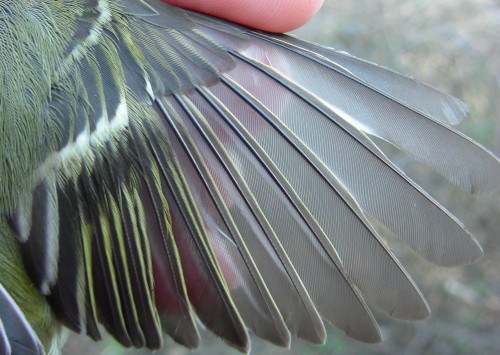
A more distinctly ASY wing, with noticeably broad primary coverts and distinctly
round-ended primaries.
Photo by Marie-Anne Hudson,
McGill Bird Observatory (QC), April 2009
ASY kinglets tend to have rectrices that are more broad and rounded than those of SY birds, but there is a fair amount of variability and by spring the tail may be somewhat worn and difficult to assess reliably. If the wing characteristics are also unclear, such an individual should be considered AHY.
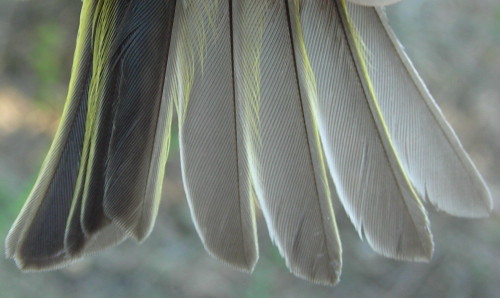
A distinctly ASY tail, with broad and fairly round-tipped rectrices.
Photo by Marie-Anne Hudson,
McGill Bird Observatory (QC), April 2009
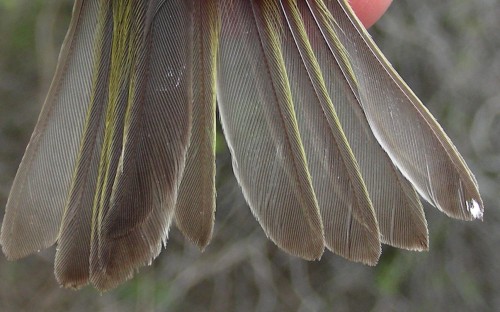
A somewhat more worn tail, a bit later in spring than the previous example, but note
that the outer rectrices are still fairly broad, even if not as rounded at the tip.
Photo by Marie-Anne Hudson,
McGill Bird Observatory (QC), May 2008
RETURN TO AGE/SEX
OVERVIEW
|
JAN - JUL: second-year
male |
As with ASY Ruby-crowned Kinglets, SY males are easily distinguished from females by their ruby crown when it is visible, but it may be largely to entirely concealed much of the time. In most cases, ageing requires careful examination of both the wing and tail.
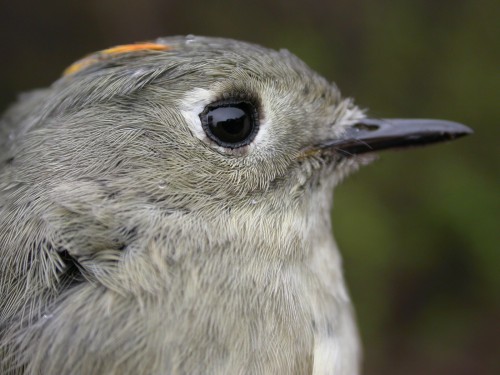
A side view with only a bit of colour visible in the crown.
Photo by Marcel Gahbauer,
McGill Bird Observatory (QC), May 2006
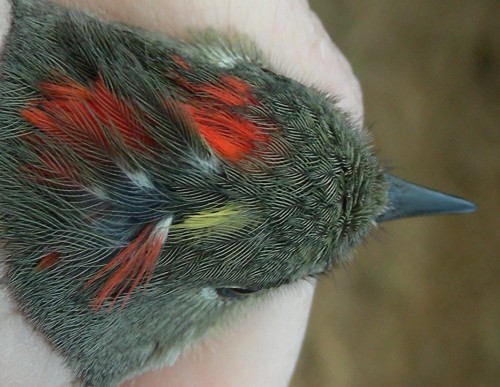
A top view of a different SY male, with more colour visible; note that occasionally some
of the central crown feathers may be yellow or orange instead of red.
Photo by Marie-Anne Hudson,
McGill Bird Observatory (QC), April 2008
Although molt limits typically occur on SY kinglets between the median and greater coverts, or sometimes among the inner greater coverts, these are generally indistinct and difficult to recognize with certainty. However, the wing overall tends to be somewhat duller than on ASY kinglets, on average shows somewhat more wear, and has less green edging, especially on the primary coverts and secondaries.
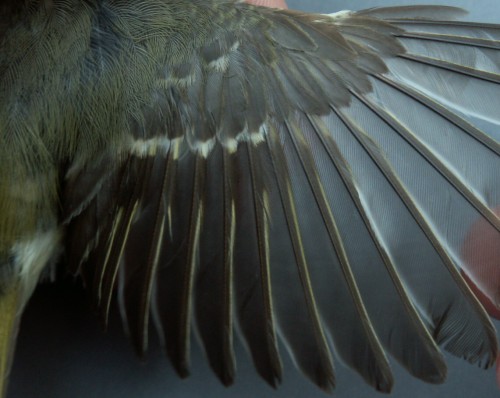
A fairly typical SY wing, dull and fairly worn overall, with relatively narrow and pointed
primary coverts
largely lacking greenish edging.
Photo by Manon Dubé, Banff
National Park (AB), June 2007
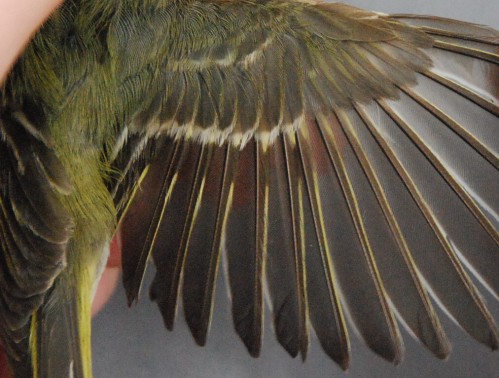
A slightly greener wing overall, but still with minimal edging on the feathers.
Photo by Manon Dubé, Banff
National Park (AB), June 2007
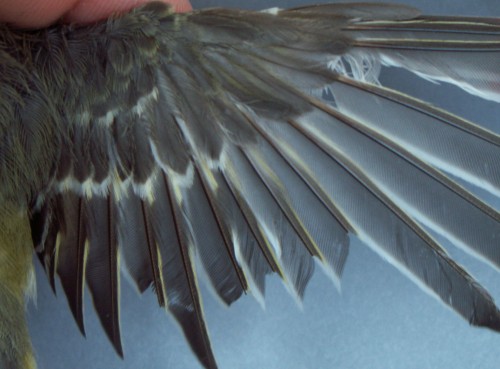
An extremely worn wing, shortly before the prebasic molt.
Photo by Manon Dubé, Banff
National Park (AB), June 2007
SY kinglets generally retain their juvenile rectrices, which on average are narrower and more pointed than the basic feathers of ASY kinglets, and also tend to be somewhat more worn by spring.
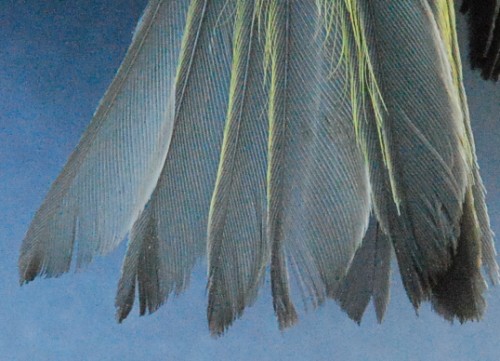
A typical SY kinglet tail, with the outer rectrices quite tapered and worn at the tips.
Photo by Manon Dubé, Banff
National Park (AB), June 2007
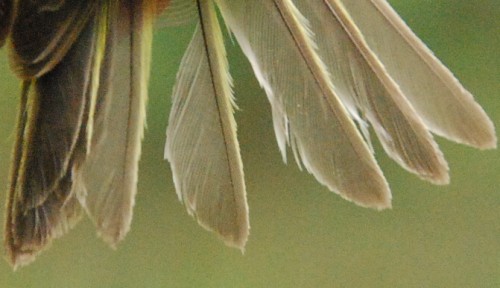
An even more worn and faded example.
Photo by Manon Dubé, Banff
National Park (AB), June 2007
RETURN TO AGE/SEX
OVERVIEW
|
JAN - JUL: second-year
female |
SY females have olive crowns without red or red-orange feathers. As with males, a good view of the wing and tail is usually required to determine age, and even then there may be many intermediates that are more safely aged as AHY, especially late in spring.
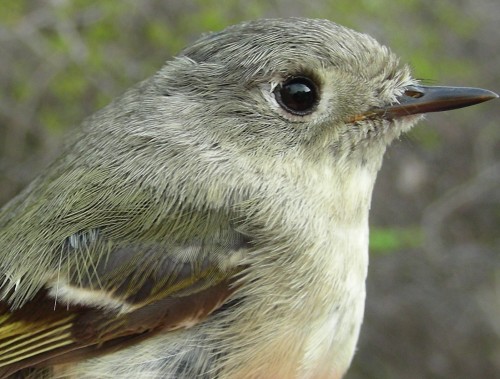
Photo by Marie-Anne Hudson,
McGill Bird Observatory (QC), May 2008
As with SY males, SY females typically have molt limits between the median and greater coverts, or sometimes among the inner greater coverts, but these are usually indistinct and difficult to recognize with certainty. However, the wing overall tends to be somewhat duller than on ASY females, on average shows somewhat more wear, and has less green edging, especially on the primary coverts and secondaries.
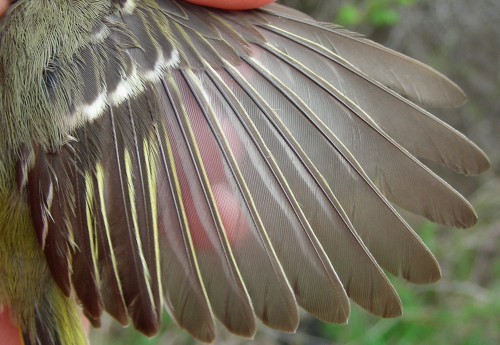
A rather "good-looking" wing for a SY kinglet, but note the narrow and pointed outer
primary coverts, with limited greenish edging.
Photo by Marie-Anne Hudson,
McGill Bird Observatory (QC), May 2008
SY kinglets generally retain their juvenile rectrices, which on average are narrowre and more pointed than the basic feathers of ASY kinglets, and also tend to be somewhat more worn by spring.
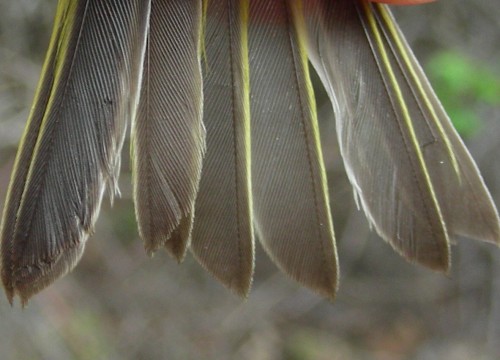
A typical SY kinglet tail, with narrow and pointed rectrices.
Photo by Marie-Anne Hudson,
McGill Bird Observatory (QC), May 2008
RETURN TO AGE/SEX
OVERVIEW
|
JUL - DEC: after-hatch-year
male |
AHY males are easily distinguished from AHY females when their large
ruby-red crown is visible, but beware that it can be mostly to entirely concealed. Ageing requires a good view of the wing and tail, or checking for skull pneumatization (until early October).
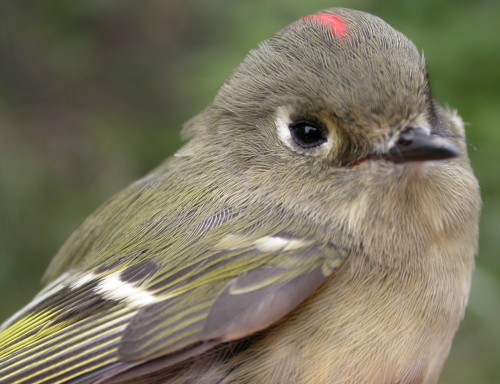
An AHY male showing a bit of its ruby crown.
Photo by Marcel Gahbauer,
McGill Bird Observatory (QC), September 2005
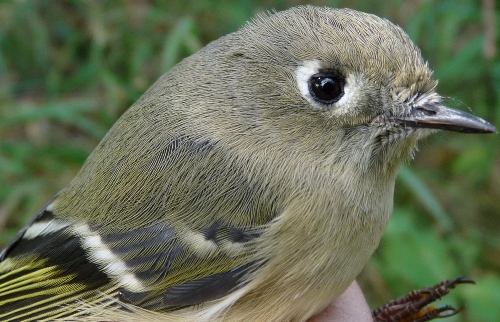
A more typical view of a male, with the ruby crown not at all visible from this angle.
Photo by Marcel Gahbauer,
McGill Bird Observatory (QC), October 2009
ASY kinglets have a uniformly fresh wing, with broad primary coverts featuring distinct greenish edging.
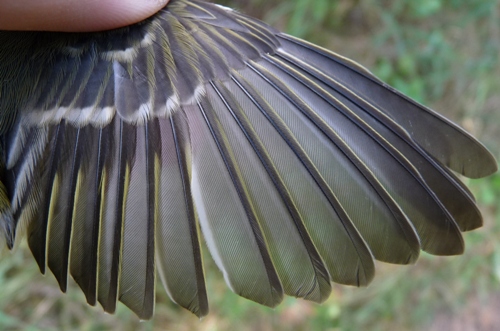
A typical AHY wing, dark and fresh, with distinct greenish edging on the primary coverts.
Photo by Marcel Gahbauer,
McGill Bird Observatory (QC), October 2009
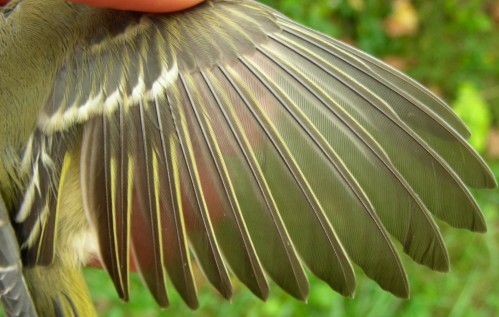
Another example also showing broad primary coverts with green edging, but note the
overall paler appearance of the wing, influenced by the lighting of the photo.
Photo by Marie-Anne Hudson,
McGill Bird Observatory (QC), October 2007
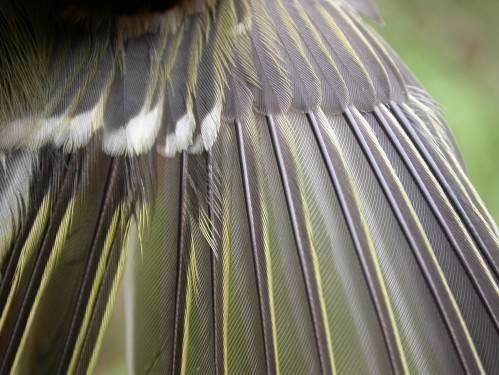
A close-up showing the broad and rounded primary coverts with distinct green edging.
Photo by Marcel Gahbauer,
McGill Bird Observatory (QC), September 2005
AHY kinglets typically have broad and rounded rectrices; those that do are readily aged by this feature, but note that there are many intermediates that require confirmation by wing or skull.
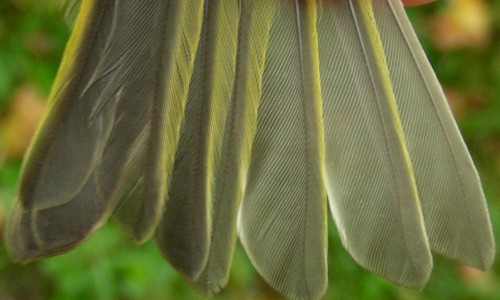
A typical AHY tail, with broad and relatively rounded outer rectrices.
Photo by Marie-Anne Hudson,
McGill Bird Observatory (QC), October 2007

A relatively uncommon variant, with rectrices that are as broad as usual for an AHY
kinglet, but taper to a distinct point at the tip.
Photo by Marcel Gahbauer,
McGill Bird Observatory (QC), October 2009
RETURN TO AGE/SEX
OVERVIEW
|
JUL - DEC: after-hatch-year
female |
Females have olive crowns, but may sometimes have 1-2 red or red-orange crown feathers. As with males, ageing requires a good view of the wing and tail, or checking for skull pneumatization (until early October).
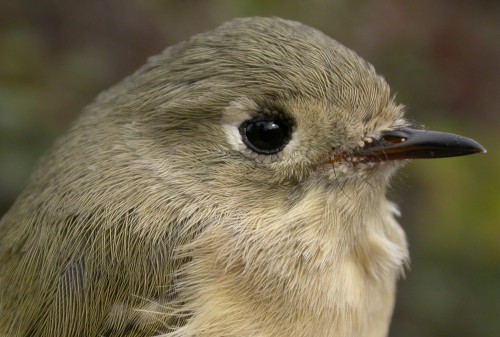
A typical AHY female.
Photo by Marcel Gahbauer,
McGill Bird Observatory (QC), October 2004
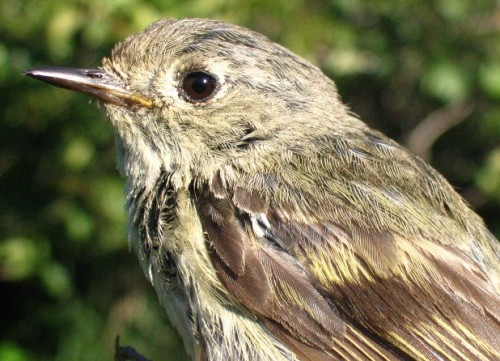
In late summer or early fall, AHY kinglets undergoing molt have a much scruffier appearance.
Photo by Seabrooke Leckie,
McGill Bird Observatory (QC), August 2006
AHY kinglets have a uniformly fresh wing, with broad primary coverts featuring distinct greenish edging.
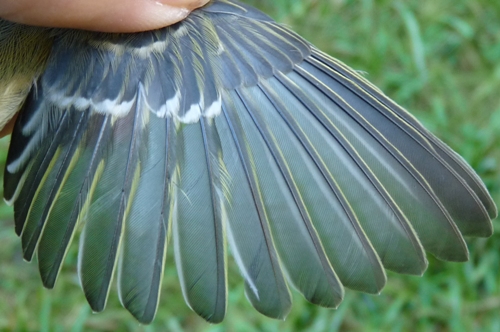
A typical AHY kinglet wing, dark and fresh, with broad and rounded primary
coverts showing distinct greenish edging, also present on the secondaries.
Photo by Marcel Gahbauer,
McGill Bird Observatory (QC), October 2010
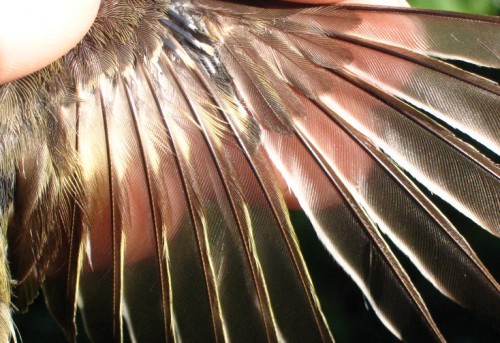
The same individual as in the previous section, photographed while undergoing its
prebasic molt, with a number of pin feathers visible in this photo. Note that the colour
and contrast is accentuated by this photo being taken in bright sunlight.
Photo by Seabrooke Leckie,
McGill Bird Observatory (QC), August 2006
AHY kinglets typically have broad and rounded rectrices; those that do are readily aged by this feature, but note that there are many intermediates that require confirmation by wing or skull.
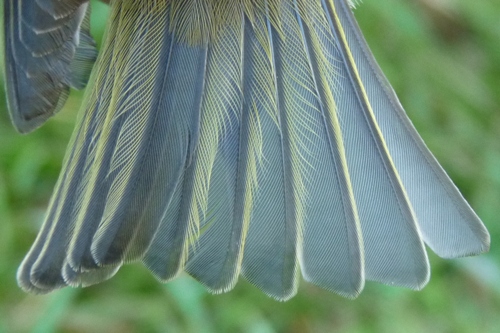
An extreme example, with very broad and blunt-tipped rectrices.
Photo by Marcel Gahbauer,
McGill Bird Observatory (QC), October 2010
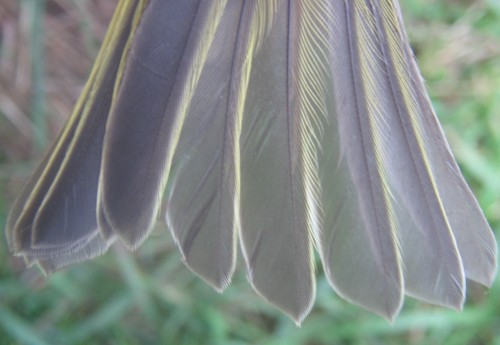
A more typical example, broad, but not quite as blunt at the tip.
Photo by Marie-Anne Hudson,
McGill Bird Observatory (QC), September 2005
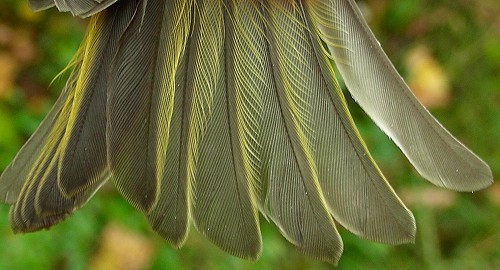
Another example, a bit pointed at the tip, but still more broad and rounded than
would be expected on a typical HY kinglet (still, worth checking wing and/or skull
to confirm individuals like this with a less than extremely distinct adult tail).
Photo by Marie-Anne Hudson,
McGill Bird Observatory (QC), October 2007
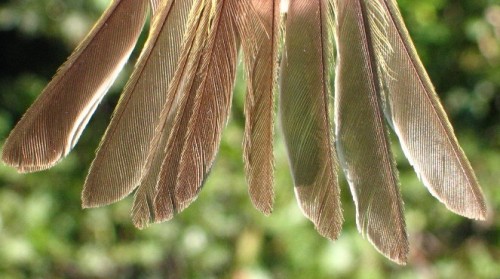
This photo corresponds to the AHY bird in molt in previous sections; note that it appears
substantially narrower and more worn; although the bleaching is accentuated by the
sunlight, it is distinctly browner than the fresh feathers typically seen in fall.
Photo by Seabrooke Leckie,
McGill Bird Observatory (QC), August 2006
RETURN TO AGE/SEX
OVERVIEW
|
JUL - DEC: hatch-year
male |
As with AHY males, the sex of HY males can be determined easily if their ruby crown is visible, but it is often largely to entirely concealed. Again, ageing usually requires a good look at the wing and tail, though until pneumatization completes (as early as the beginning of October), the most reliable confirmation for HY birds is the presence of an incomplete skull.
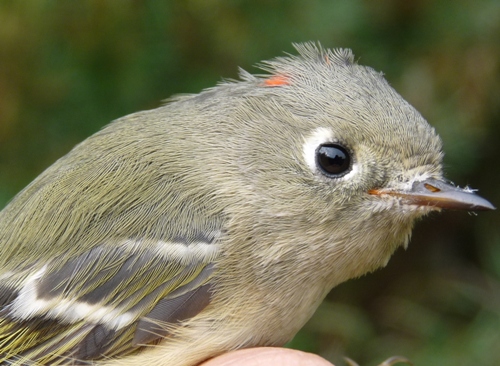
A HY male showing a hint of red in the crown.
Photo by Marcel Gahbauer,
McGill Bird Observatory (QC), October 2010
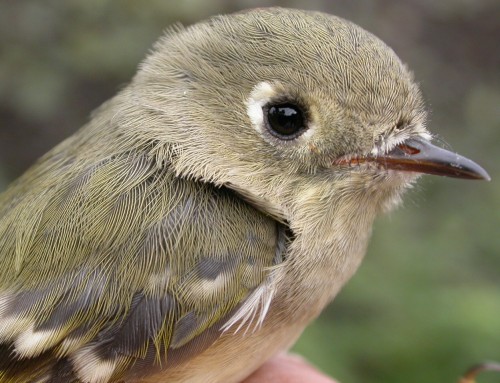
A more typical view, with no red visible.
Photo by Marcel Gahbauer,
McGill Bird Observatory (QC), September 2005
Molt limits in HY kinglets typically occur between the median coverts and greater coverts, or sometimes among the inner greater coverts. Sometimes these are apparent when the replaced feathers are fresh, but more often the distinction is too subtle to be reliable. Juvenile primary coverts on HY kinglets are on average somewhat narrower and more pointed than the basic feathers of AHY birds, but beware that this distinction can be more difficult to see in fall when feathers are fresh; similarly, by spring the minimal green edging to the juvenile primary coverts has often worn off, helping distinguish them from basic feathers, but when fresh in fall they may look quite similar. Therefore since most HY wings in fall are only subtly different from AHY wings, tail is the best plumage feature to use in most cases, and skull development should be checked in most cases.
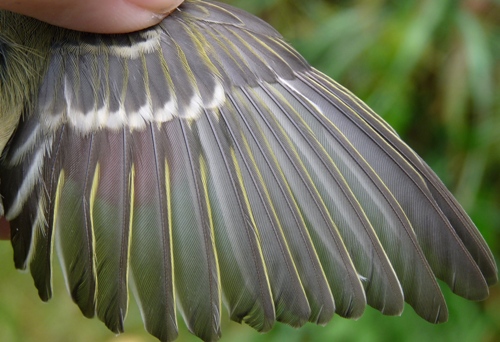
A relatively dark and fresh HY wing. Although exagerated a bit by the shadow from the
finger holding the wing, there is
a molt limit between the darker replaced median coverts
and the duller retained greater coverts. Note also that while the primary coverts have a bit
of green edging, they are not particularly broad.
Photo by Marcel Gahbauer,
McGill Bird Observatory (QC), October 2010
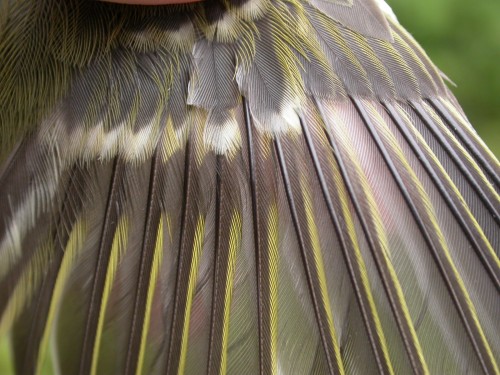
Another example showing a contrast between the median and greater coverts; again the
primary coverts have green edging, but note that they are relatively narrow and pointed.
Photo by Marcel Gahbauer,
McGill Bird Observatory (QC), September 2005
HY kinglets retain juvenile rectrices that are typically narrower and more pointed than those of AHY kinglets. This is often the most reliable plumage clue for ageing, but beware that a fair proportion of kinglets have tails with an intermediate shape, and should be aged only if skull development provides a definitive answer.
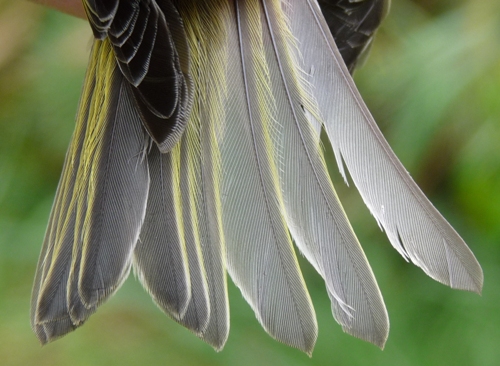
A relatively typical HY tail, with fairly narrow and pointed outer rectrices.
Photo by Marcel Gahbauer,
McGill Bird Observatory (QC), October 2010
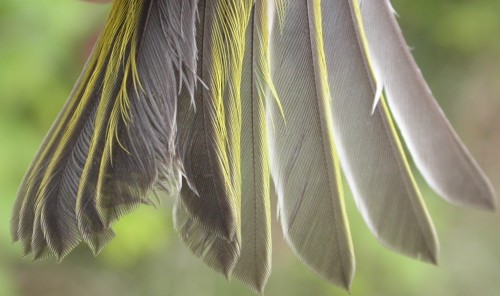
Another example, with some feathers slightly broader, but with a more pointed shape.
Photo by Marcel Gahbauer,
McGill Bird Observatory (QC), September 2005
RETURN TO AGE/SEX
OVERVIEW
|
JUL - DEC: hatch-year
female |
As with AHY females, HY females have olive crowns without ruby feathers, but bear in mind that many males appear identical when their ruby crown feathers are concealed.
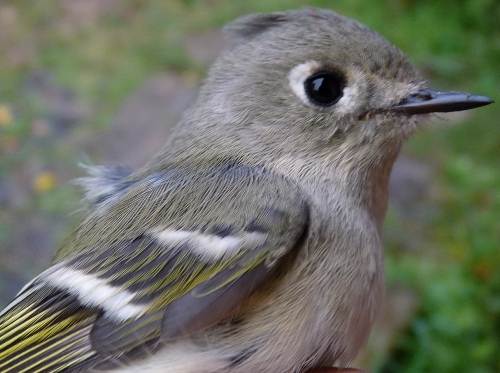
Photo by Marcel Gahbauer,
McGill Bird Observatory (QC), October 2009
As with males, molt limits in female HY kinglets typically occur between the median coverts and greater coverts, or sometimes among the inner greater coverts. Sometimes these are apparent when the replaced feathers are fresh, but more often the distinction is too subtle to be reliable. Juvenile primary coverts on HY kinglets are on average somewhat narrower and more pointed than the basic feathers of AHY birds, but beware that this distinction can be more difficult to see in fall when feathers are fresh; similarly, by spring the minimal green edging to the juvenile primary coverts has often worn off, helping distinguish them from basic feathers, but when fresh in fall they may look quite similar. Therefore since most HY wings in fall are only subtly different from AHY wings, tail is the best plumage feature to use in most cases, and skull development should be checked in most cases.

This example illustrates the lack of any obvious molt limits on the wing, but note
the narrow and pointed shape of the primary coverts.
Photo by Marcel Gahbauer,
McGill Bird Observatory (QC), October 2009
HY kinglets retain juvenile rectrices that are typically narrower and more pointed than those of AHY kinglets. This is often the most reliable plumage clue for ageing, but beware that a fair proportion of kinglets have tails with an intermediate shape, and should be aged only if skull development provides a definitive answer.
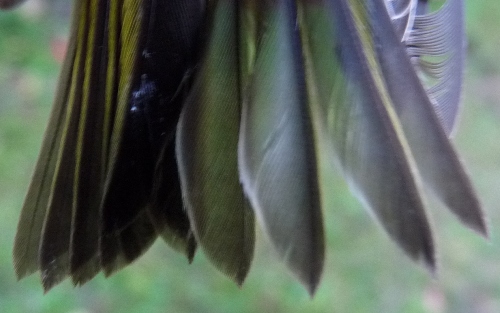
A particularly extreme example, with very narrow and pointed outer rectrices.
Photo by Marcel Gahbauer,
McGill Bird Observatory (QC), October 2009
RETURN TO AGE/SEX
OVERVIEW